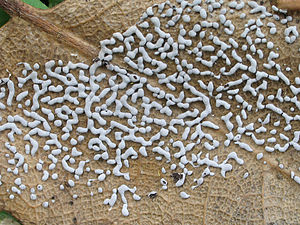Diderma
| Diderma | ||||||||||||
|---|---|---|---|---|---|---|---|---|---|---|---|---|

|
||||||||||||
| Systematics | ||||||||||||
|
||||||||||||
| Scientific name | ||||||||||||
| Diderma | ||||||||||||
| Pers. 1794 |
Diderma is a genus of slime molds ( Myxomycetes ) from the order Physarida .
Type species is Diderma globosum .
features
The fructifications are formed as pedicled or sessile sporocarp or plasmodiocarp . The cover ( peridia ) has two, rarely three layers. Their outer layer consists either of a solid crust of amorphous lime globules (subgenus Diderma ) or of cartilaginous, amorphous lime or pseudocrystalline limestone flakes (subgenus Leangium ). The inner layer is thin and transparent like a membrane. In double peridia it is loosely or firmly connected to the outer layer. With triple peridia, the middle layer is firmly attached to the outer one.
The thin scalp is branched or networked. Sometimes there are granular to nodular deposits or spindle-like thickenings. Usually the scalp is free of lime. A columella is usually present. It is often spherical to hemispherical or cylindrical in shape. More rarely, it is only formed from a thickened base of fructification.
The spores are dark brown to black in bulk. They appear gray to purple-brown in transmitted light.
Generic delimitation
The genus Didymium is related to Diderma . To distinguish between the two groups, see there.
Systematics
Within the genus, a distinction is made between the subgenus Diderma and Leangium . The former has a fragile, rough or eggshell-like, smooth outer peridium layer that is hardly or firmly connected to the inner layer. Species of the subgenus Leangium have a cartilaginous and smooth outer layer, which is usually firmly connected to the middle or inner layer. The peridia often tears open in a star shape. Plasmodiocarps are usually only formed from the Diderma subgenus .
species
The genus Diderma comprises over 70 species worldwide. Around 30 species are specified for Central Europe:
- Diderma alpinum
- Diderma asteroides
- Diderma carneum
- Diderma chondrioderma
- Diderma cinereum
- Diderma cingulatum
- Diderma crustaceum
- Diderma deplanatum
- Diderma donkii
- Diderma effusum
- Diderma floriform
- Diderma globosum
- Diderma hemisphaericum
- Diderma lyallii
- Diderma microcarpum
- Diderma montanum
- Diderma nivale
- Diderma niveum
- Diderma ochraceum
- Diderma radiatum
- Diderma roanense
- Diderma rufum
- Diderma sauteri
- Diderma simplex
- Diderma spumarioides
- Diderma subviridifuscum
- Diderma testaceum
- Diderma trevelyanii
- Diderma umbilicatum
literature
- Hermann Neubert , Wolfgang Nowotny , Karlheinz Baumann , Heidi Marx: The Myxomycetes of Germany and the neighboring Alpine region with special consideration of Austria . tape 2 . Karlheinz Baumann Verlag, Gomaringen 1995, ISBN 3-929822-01-6 , p. 32 f .
